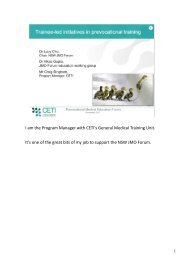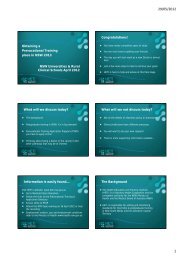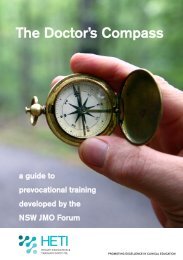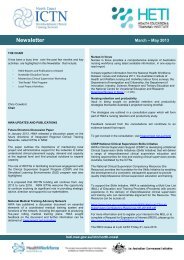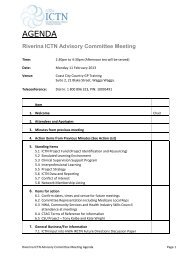Open - HETI - NSW Government
Open - HETI - NSW Government
Open - HETI - NSW Government
- No tags were found...
You also want an ePaper? Increase the reach of your titles
YUMPU automatically turns print PDFs into web optimized ePapers that Google loves.
Top ten tips for the teaching supervisorThe educational role1. Every little bit helps: Seize the teaching moment.Even if you don’t have the whole package workedout, it’s still worthwhile sharing what you can,as best you can. Don’t have time to run through aprocess or procedure in full? Draw the supervisee’sattention to one key aspect of the task.No time for a complete debrief immediately aftera difficult case? Ask a few key questions to checkthe supervisee’s understanding of what occurredand give quick feedback. Follow up later whenthere is time.2. Teach by guided questioning: Ask questionsto discover the state of the supervisee’s knowledgeand understanding. Encourage independent thinkingand problem-solving. Effective questioning uncoversmisunderstandings and reinforces and extendsexisting knowledge. Questions keep superviseesengaged, “on their toes”, listening and thinking.3. Invite supervisees to set the agenda: Adult learnersshould be involved in decisions about the directionand content of learning. Your ultimate objective asa supervisor is to foster the supervisee’s abilityfor self-directed lifelong learning.4. Encourage questions: Questions fromsupervisees should always be treated with respect.You may be shocked at what they did not know,but on closer inspection, may discover that othersare just keeping quiet. The three most importantwords in teaching and learning are “I don’t know”.5. Focus the learner: Start any teaching by settingup the importance of the session. Teaching ismore effective if it is tailored to learners’ interests,ambitions and current level of knowledge and ability.Answer the question: why should they pay attentionto what you are about to teach them?6. Focus the learning: Don’t try to teach too muchat once. Try not to repeat what is already known.Clinical situations are complex but limit the learningto the key aspects that form the learning edgeof your audience’s knowledge base. Proceduresand processes can be broken down into steps,not all of which have to be covered at once.7. Encourage independent learning: Don’t tryto teach everything – give enough information to setsupervisees on track, then ask them to complete thetask themselves. Set tasks that require superviseesto act on the information you have provided. Keeplearning open-ended. Encourage superviseesto seek other educational opportunities and reportback on their learning.8. Teach evidence-based practice: Build a lifelonglearning attitude in your supervisees.Even more important than knowing the currentbest answer to a clinical problem is having the skillsto identify a clinical question, search the clinicalliterature, appraise the evidence and form anevidence-based plan.9. Check the understanding of supervisees:Have supervisees actually understood what hasbeen taught? Can they demonstrate clinicalreasoning and put knowledge and skills intopractice? If not, perhaps revisit specific topicsor skill areas until supervisees feel confidentand can show that they have learned.10. Evaluate your own practice as a teacher:How well did your supervisee learn from theinformation you provided? Every time you teach youhave a chance to learn how to do it better (and moreeasily) next time. Try different methods and comparesupervisee outcomes. Seek feedback from yoursupervisees. Compare notes with your peers.FIRST EDITION<strong>HETI</strong> The Superguide37



